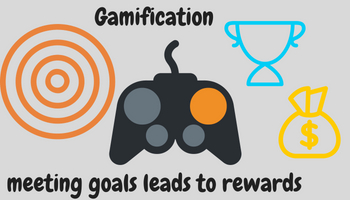Gamification Provides Mutual Benefits to Employer and Employees
Tags: Gamification, Snowfly Incentives, Productivity, Communication Is Our Business, Motivation, Workplace
If you watched the recent NBA Draft Lottery, the event had a decidedly Vegas feel. With each of the
bottom 14 teams in the league assigned chances based upon reverse order of this year’s record,
excitement was created by watching the ping pong balls spin in the lottery machine – and, knowing the
odds of the #1 pick for each team, the audience was clearly invested in the process.
This, says Darrin Briggs, President and CEO of Snowfly Incentives, is gamification in action. Gamification has become a common tool in today’s workplace to increase employee productivity, engagement, and job satisfaction.
When you think about it, the principles of gamification are all around us, such as at the grocery store, fitness apps, and Facebook. Briggs defines gamification as “Taking activities in life or in business and adding gaming aspects to an otherwise somewhat mundane activity.” Gamification does not mean playing video games necessarily; but it does involve reinforcing behaviors that will then have a positive outcome for the business and individual.
 By creating small, incremental positive behaviors, a cultural shift occurs that moves everyone in the right
direction. When these behaviors are tied to business goals, the program is meaningful to staff members.
While gamification has taken a foothold in the business world, not all programs are created equally.
Briggs estimates that 80 percent of companies administer gamification manually, while 20 percent use
some sort of automated program.
By creating small, incremental positive behaviors, a cultural shift occurs that moves everyone in the right
direction. When these behaviors are tied to business goals, the program is meaningful to staff members.
While gamification has taken a foothold in the business world, not all programs are created equally.
Briggs estimates that 80 percent of companies administer gamification manually, while 20 percent use
some sort of automated program.
Snowfly Incentives is one of these automated programs, offering an employee recognition and incentive system that uses principles of psychology and behavior modification. The business was created in 1999 by Dr. Brooks Mitchell, a behavioral psychologist, who specializes in workplace environments. Computer analysis, and now AI (Artificial Intelligence), utilized by Snowfly quickly determines what’s working, so that changes can be made on the fly for the most effective program tailored to each company.
This is a culture shift in the workplace. As Briggs says “it’s not a manager’s job to motivate people. What you have to do is create an environment where people feel valued and are motivated by whatever motivates them.” Snowfly knows that employees are motivated by different things: for some, it’s money; others prefer time off, the chance to wear jeans at work, a close-up parking spot … the list goes on.
“Our job is to create an environment to motivate people naturally,” says Briggs. “This does not mean you’re playing video games all day. It’s an aspect of taking something that has to do with gaming, but put it into an environment where you don’t see it.”
The Snowfly system has an interface that users log into, with a dashboard displaying their performance of different metrics, leaderboards, and standards. Employees can then “level up” (i.e. work their way up) to earn greater rewards. And Snowfly’s real-time incentives provide immediate rewards – there’s no waiting until the end of the week, month, or quarter to be awarded. Briggs says “If you want to change a behavior, you have to reinforce that behavior as quickly as possible after it was performed.” This goes back to Psychology, and the research of B.F. Skinner and Pavlov.
Another thing that makes Snowfly probably the most unique to the gamification market: by employing Vegas-style principles such as slot-machine style games, an aspect of luck (or chance) increases the effectiveness of the program and the long-term engagement by employees. For various goals met, employees are rewarded with tokens for game play, which then brings possibly larger rewards. The anticipation of the potential reward is part of the fun, and creates buy-in from employees. For employers, the costs are fairly minimal; however, the perceived value, says Briggs, is as much as 40 percent higher than the actual cost.
This, says Darrin Briggs, President and CEO of Snowfly Incentives, is gamification in action. Gamification has become a common tool in today’s workplace to increase employee productivity, engagement, and job satisfaction.
When you think about it, the principles of gamification are all around us, such as at the grocery store, fitness apps, and Facebook. Briggs defines gamification as “Taking activities in life or in business and adding gaming aspects to an otherwise somewhat mundane activity.” Gamification does not mean playing video games necessarily; but it does involve reinforcing behaviors that will then have a positive outcome for the business and individual.
 By creating small, incremental positive behaviors, a cultural shift occurs that moves everyone in the right
direction. When these behaviors are tied to business goals, the program is meaningful to staff members.
While gamification has taken a foothold in the business world, not all programs are created equally.
Briggs estimates that 80 percent of companies administer gamification manually, while 20 percent use
some sort of automated program.
By creating small, incremental positive behaviors, a cultural shift occurs that moves everyone in the right
direction. When these behaviors are tied to business goals, the program is meaningful to staff members.
While gamification has taken a foothold in the business world, not all programs are created equally.
Briggs estimates that 80 percent of companies administer gamification manually, while 20 percent use
some sort of automated program.Snowfly Incentives is one of these automated programs, offering an employee recognition and incentive system that uses principles of psychology and behavior modification. The business was created in 1999 by Dr. Brooks Mitchell, a behavioral psychologist, who specializes in workplace environments. Computer analysis, and now AI (Artificial Intelligence), utilized by Snowfly quickly determines what’s working, so that changes can be made on the fly for the most effective program tailored to each company.
This is a culture shift in the workplace. As Briggs says “it’s not a manager’s job to motivate people. What you have to do is create an environment where people feel valued and are motivated by whatever motivates them.” Snowfly knows that employees are motivated by different things: for some, it’s money; others prefer time off, the chance to wear jeans at work, a close-up parking spot … the list goes on.
“Our job is to create an environment to motivate people naturally,” says Briggs. “This does not mean you’re playing video games all day. It’s an aspect of taking something that has to do with gaming, but put it into an environment where you don’t see it.”
The Snowfly system has an interface that users log into, with a dashboard displaying their performance of different metrics, leaderboards, and standards. Employees can then “level up” (i.e. work their way up) to earn greater rewards. And Snowfly’s real-time incentives provide immediate rewards – there’s no waiting until the end of the week, month, or quarter to be awarded. Briggs says “If you want to change a behavior, you have to reinforce that behavior as quickly as possible after it was performed.” This goes back to Psychology, and the research of B.F. Skinner and Pavlov.
Another thing that makes Snowfly probably the most unique to the gamification market: by employing Vegas-style principles such as slot-machine style games, an aspect of luck (or chance) increases the effectiveness of the program and the long-term engagement by employees. For various goals met, employees are rewarded with tokens for game play, which then brings possibly larger rewards. The anticipation of the potential reward is part of the fun, and creates buy-in from employees. For employers, the costs are fairly minimal; however, the perceived value, says Briggs, is as much as 40 percent higher than the actual cost.


